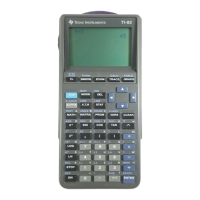8 Calculator Keystroke Guide
page 11
6 Multiply
The TI-82 interprets the following as indicating multiplication: the multiplication key ×, numbers
or expressions written side by side in parentheses, numbers and letters written side by side, and
letters written side by side. If you type
63
, the calculator will display it as 3*6. The asterisk *
is a common computer notation for multiplication. When you press ENTER, the calculator will
display the value 18. If you place one or both of the numbers in a multiplication in parentheses
without using the multiplication key, the calculator still knows that you mean to multiply. Thus,
the calculator will also produce 18 if you enter
as 3(6), (3)6, or (3)(6). Parentheses
may also be used for grouping calculations to be done in a certain order. Thus, the calculator
interprets 5(3+4) as meaning to add 3 + 4 first to get 7, and then to multiply 5 times the 7 to get
35.
As an example of placing numbers and letters side by side, the calculator interprets 3X as
meaning "3 times X." (How to enter letters will be discussed later.) To see how this way of
writing multiplication works, try typing in 2π, where π (the Greek letter pi) represents that special
number having to do with circles. The value of π is approximately 3.141592654. Your calculator
has this special number as the second function on the caret key ^. (You should see the symbol π
printed above the caret key in light blue type.) To type in 2π, type the 2 and then press the light
blue 2nd key and then the caret key. (In the future we will denote these last two keystrokes as 2nd
[π].) Your calculator should display 2π. Press ENTER to see the value 6.283185307, which is two
times the value of π.
page 11
7 Divide
See 1 Divide.
page 12
8 Exponent
The caret key ^ is used to enter most exponents. For example, the expression
5
, is entered into
the calculator as 2^5. Thus, the base is entered first, then the caret, and then the exponent. Press
ENTER to produce this expression’s value, 32. To raise a negative number to a power, it is
necessary to enclose the negative number base in parentheses. For example, to raise the number
−3 to the fourth power the expression must be written as
4
)3(− . Likewise, we must enter this
expression into the calculator as (-3)^4. The result is 81. Without the parentheses, -3^4
would (and should) be interpreted as taking the negative of
4
3 . That is, -3^4 is interpreted as
81)81()3(3
44
−=−=−=− .
Two special exponents that can be produced on screen as raised exponents are the exponents
2 and 3. To enter the expression
2
5 you could use the standard approach of typing 5^2, or you
could instead type the 5 and then press the
2
x key. The
2
x key produces only the raised exponent
2 on the screen, not the x. Either way, the calculator produces the result of 25 when you press
ENTER. To produce a raised exponent 3, as in the expression
3
, first type 4 and then press the
MATH key. The calculator will display the MATH menu. Choice 3 on the MATH menu is the raised
exponent 3. Select it by pressing 3 (or by using the Down Arrow key to highlight the number 3

